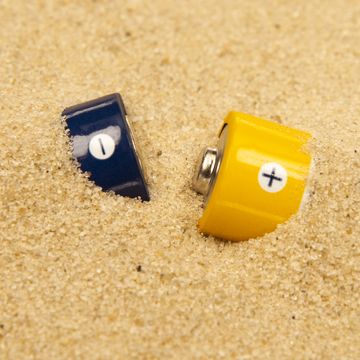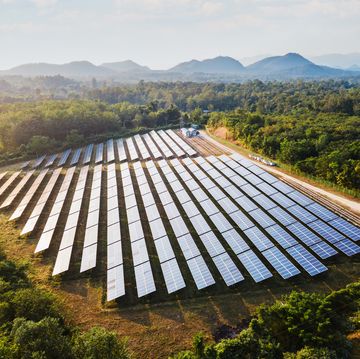- Researchers have made a bio-mimicking smart material that bends to follow the sun.
- “Tracking” solar panels gather up to 30 percent more energy than static solar panels.
- Time will tell if these tiny flowers are practical for solar energy collection.
Plants bend toward the sun in a behavior called phototropism, which scientists have mimicked in a light-responsive artificial “sunflower” that can harvest solar energy. New Scientist reports that the design, which is micro-sized at less than one millimeter in diameter, uses materials that expand and contract with heat in order to bend toward the sun’s warm light.
The scientists behind the tiny sunflowers published their findings in Nature Nanotechnology, explaining their rationale in using responsive “smart materials” in order to model the natural phototropism exhibited by plants. The mechanism of sun reaction itself is the major thrust of the research.
Either way, having an effective way to use smart materials to pivot solar collectors toward the sun may mean more efficient collection and use of solar energy. Among existing solar panel technology, consumers can choose static panels or tracking panels. Static solar panels are mounted at a specific location and angle and can’t move from that position. Tracking panels do just what they say on the label: They angle toward the sun’s light by tilting on one or even two axes throughout the day. Tracking panels are thought to be 15 to 30 percent more effective at gathering solar energy.
The tiny sunflower nanotechnology presented by UCLA’s Ximin He and her team may offer new use cases for solar energy collection, compared with traditional solar cell panels, which are large and bulky and may seem intrusive in residential neighborhoods or commercial districts. He’s research focuses on “biologically inspired materials” like the sunflowers, where polymers mimic the natural responses of plant, animal, or even fungal organisms in order to work more efficiently.
Traditional solar panels are mostly photovoltaic, meaning they gather solar energy directly into electricity in real time. This can be impractical outside of daylight hours because it’s hard to transfer the energy into a storable format. The tiny sunflowers have potential for generating thermal solar energy, which is an array of gathering cells intersticed with a liquid or gas that conducts heat. If a liquid is used, this may be called solar vapor energy, and it works much like a traditional steam engine or generator. Because this heat travels through an energy-efficient medium, it can be stored more easily.
He’s team found the sunflowers increased gathering potential over static, oblique solar panels by 400 percent, which may put them on par with traditional one- or two-axis tracking panels. Using thermal solar instead of photovoltaic processes may make the sunflowers more suited to scenarios where traditional solar panels aren’t effective or where energy storage is important, and the micro scale of the polymer sunflowers may mean they can be installed on smaller surfaces with more user-friendly or aesthetically pleasing results.
For now, the sunflowers themselves are the news, including the smart material that innately reacts to heat in order to reorient itself. Strangely, life imitates art, because the 2019 Netflix original romantic comedy Falling Inn Love includes a responsive solar flower as a major plot element. “A zero-net energy, solar powered B&B, all due to Gabriela’s solar flower,” one character says. “It rotates, collecting the sun’s energy all day long.”
A shot of a smart micropolymer wouldn’t be very dramatic, but they’re actually using the real-life SmartFlower, a folding, dual-axis petaled photovoltaic panel that claims to improve on traditional static panels by 40 percent.

Caroline Delbert is a writer, avid reader, and contributing editor at Pop Mech. She's also an enthusiast of just about everything. Her favorite topics include nuclear energy, cosmology, math of everyday things, and the philosophy of it all.












